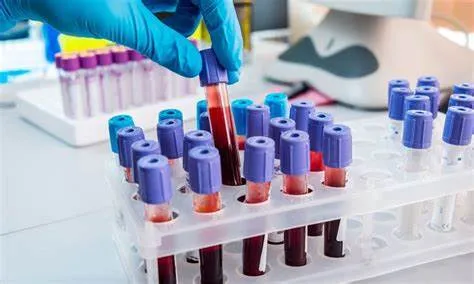Pancreatic cancer is one of the most lethal forms of cancer, often diagnosed at an advanced stage when treatment options are limited, and survival rates are bleak. Recent advancements in early detection methods could offer hope for patients and significantly impact the fight against this deadly disease. At the forefront of these innovations is a promising new blood test developed by researchers at Oregon Health & Science University (OHSU). This breakthrough test, known as PAC-MANN, uses a small blood sample to detect key biological indicators of pancreatic cancer, enabling earlier detection with 85% accuracy.
The Development of PAC-MANN: A Game Changer for Early Detection
Pancreatic cancer, specifically pancreatic ductal adenocarcinoma (PDAC), is the most common and deadliest form of the disease. One of the primary reasons for its high mortality rate is that it is often diagnosed at a late stage when treatment options are limited. Current tests, such as the carbohydrate antigen 19-9 (CA 19-9) test, can be used to measure the progression of the disease and indicate prognosis. However, these tests lack the sensitivity needed for early-stage detection, making it challenging to catch the disease before it becomes too advanced to treat effectively.
PAC-MANN, which stands for “protease activity-based assay using a magnetic nanosensor,” is a revolutionary test that aims to fill this gap. Researchers at OHSU have developed a way to detect changes in protease activity in the blood, a key biological marker for PDAC. This new test could help clinicians detect the disease much earlier, increasing the chances of survival by providing more time for treatment.
How PAC-MANN Works: The Science Behind the Test
The PAC-MANN test works by analyzing small blood samples for changes in protease activity. Proteases are enzymes that play a crucial role in the development of cancer by breaking down proteins and enabling cancer cells to grow and spread. In patients with pancreatic cancer, these proteases become more active, making them a reliable biomarker for early-stage detection.
The test is based on the use of a magnetic nanosensor, which is capable of detecting subtle changes in protease activity at a molecular level. Researchers at OHSU used blood samples from 350 patients who either had pancreatic cancer, were at high risk for the disease, or were healthy controls. The team identified specific proteases that became more active in individuals with PDAC, allowing them to develop a test capable of accurately distinguishing between healthy individuals, those with non-cancerous pancreatic conditions, and those with pancreatic cancer.
High Accuracy and Early Detection
One of the most impressive features of the PAC-MANN test is its high accuracy. The test was able to distinguish patients with pancreatic cancer from healthy individuals and those with non-cancerous pancreatic conditions 98% of the time. Furthermore, when used in conjunction with the existing CA 19-9 test, PAC-MANN was able to detect early-stage pancreatic cancer with 85% accuracy, a significant improvement over current methods.
This high level of accuracy is critical for improving the prognosis of patients with pancreatic cancer. By detecting the disease at an earlier stage, when treatment options are more effective, patients may have a greater chance of survival. The ability to accurately detect early-stage cancer also opens the door to more aggressive treatment options, such as surgery, chemotherapy, and radiation therapy, which are often more successful when initiated earlier.
Monitoring Treatment Effectiveness
In addition to its diagnostic capabilities, the PAC-MANN test has the potential to help monitor how well treatments are working. Researchers observed that after patients underwent surgery, protease activity in their blood decreased, suggesting that the test could be used to track a patient’s response to therapy. This could allow doctors to make more informed decisions about treatment plans, adjusting therapies as needed based on real-time data about how well the patient is responding.
“The ability to track a patient’s response to therapy in real-time could help doctors make better treatment decisions, ultimately improving patient outcomes,” said Jared Fischer, Ph.D., a scientist with the OHSU Knight Cancer Institute. “This test is not just about detection; it could also guide treatment and help ensure that patients receive the most effective therapies.”
A Cost-Effective and Accessible Solution
Another major advantage of PAC-MANN is its cost-effectiveness and accessibility. Traditional cancer detection methods, such as endoscopic ultrasounds and liquid biopsies, often require large volumes of blood and can be expensive, making them less accessible for many patients, especially those in rural or underserved areas. In contrast, PAC-MANN requires only a tiny blood sample—just 8 microliters—and can be run in as little as 45 minutes. The cost of the test is also remarkably low, with the entire process costing less than a penny per sample.
This low cost and quick turnaround time make PAC-MANN a promising option for widespread screening, particularly in areas where access to specialized medical facilities is limited. The test could be used for individuals who are at high risk of pancreatic cancer but are not currently targeted by existing screening methods. By enabling more frequent screenings, PAC-MANN could help detect pancreatic cancer earlier in high-risk populations, ultimately saving lives.
Plans for Future Trials and Clinical Use
While the PAC-MANN test has shown great promise in early studies, the researchers at OHSU are planning further trials to validate its effectiveness in larger patient populations. These trials will be critical in determining how the test performs in real-world clinical settings and whether it can be used as a routine screening tool for pancreatic cancer. The OHSU team has already initiated plans for an investigator-initiated trial in collaboration with the OHSU Knight Cancer Institute and CEDAR, focusing on patients at high risk of developing pancreatic cancer.
If further clinical validation is successful, PAC-MANN could become a valuable tool in the early detection of pancreatic cancer, giving patients more treatment options and improving their chances of survival. The researchers hope that the test will eventually be used as part of routine screening programs for high-risk individuals, helping catch the disease before it becomes too advanced.
A Step Toward Ending Pancreatic Cancer
The development of the PAC-MANN test represents a major step forward in the fight against pancreatic cancer. By offering a quick, inexpensive, and highly accurate method for detecting the disease at an early stage, PAC-MANN could help improve survival rates for one of the deadliest cancers. The ability to monitor treatment effectiveness in real-time could also help doctors make better-informed decisions about patient care, further improving outcomes.
As the researchers continue their work to validate the test and bring it to clinical practice, they remain hopeful that PAC-MANN could become a vital tool in the early detection of pancreatic cancer. “Hopefully, this is one step toward ending cancer as we know it,” said Fischer. If successful, PAC-MANN could become a game-changer in the battle against pancreatic cancer, offering patients a better chance at survival and giving hope to those affected by this devastating disease.























